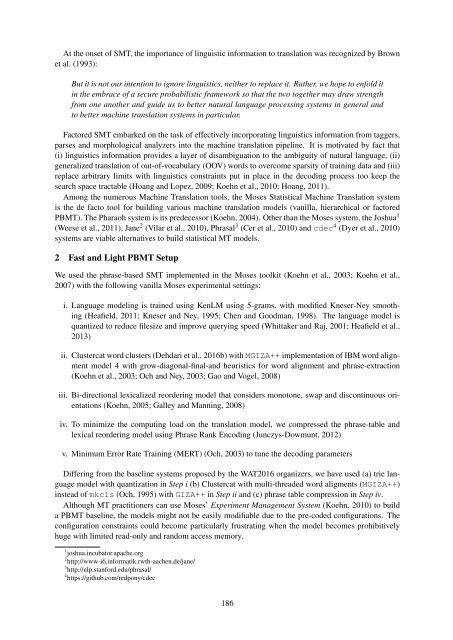December 11-16 2016 Osaka Japan
W16-46
W16-46
You also want an ePaper? Increase the reach of your titles
YUMPU automatically turns print PDFs into web optimized ePapers that Google loves.
At the onset of SMT, the importance of linguistic information to translation was recognized by Brown<br />
et al. (1993):<br />
But it is not our intention to ignore linguistics, neither to replace it. Rather, we hope to enfold it<br />
in the embrace of a secure probabilistic framework so that the two together may draw strength<br />
from one another and guide us to better natural language processing systems in general and<br />
to better machine translation systems in particular.<br />
Factored SMT embarked on the task of effectively incorporating linguistics information from taggers,<br />
parses and morphological analyzers into the machine translation pipeline. It is motivated by fact that<br />
(i) linguistics information provides a layer of disambiguation to the ambiguity of natural language, (ii)<br />
generalized translation of out-of-vocabulary (OOV) words to overcome sparsity of training data and (iii)<br />
replace arbitrary limits with linguistics constraints put in place in the decoding process too keep the<br />
search space tractable (Hoang and Lopez, 2009; Koehn et al., 2010; Hoang, 20<strong>11</strong>).<br />
Among the numerous Machine Translation tools, the Moses Statistical Machine Translation system<br />
is the de facto tool for building various machine translation models (vanilla, hierarchical or factored<br />
PBMT). The Pharaoh system is its predecessor (Koehn, 2004). Other than the Moses system, the Joshua 1<br />
(Weese et al., 20<strong>11</strong>), Jane 2 (Vilar et al., 2010), Phrasal 3 (Cer et al., 2010) and cdec 4 (Dyer et al., 2010)<br />
systems are viable alternatives to build statistical MT models.<br />
2 Fast and Light PBMT Setup<br />
We used the phrase-based SMT implemented in the Moses toolkit (Koehn et al., 2003; Koehn et al.,<br />
2007) with the following vanilla Moses experimental settings:<br />
i. Language modeling is trained using KenLM using 5-grams, with modified Kneser-Ney smoothing<br />
(Heafield, 20<strong>11</strong>; Kneser and Ney, 1995; Chen and Goodman, 1998). The language model is<br />
quantized to reduce filesize and improve querying speed (Whittaker and Raj, 2001; Heafield et al.,<br />
2013)<br />
ii. Clustercat word clusters (Dehdari et al., 20<strong>16</strong>b) with MGIZA++ implementation of IBM word alignment<br />
model 4 with grow-diagonal-final-and heuristics for word alignment and phrase-extraction<br />
(Koehn et al., 2003; Och and Ney, 2003; Gao and Vogel, 2008)<br />
iii. Bi-directional lexicalized reordering model that considers monotone, swap and discontinuous orientations<br />
(Koehn, 2005; Galley and Manning, 2008)<br />
iv. To minimize the computing load on the translation model, we compressed the phrase-table and<br />
lexical reordering model using Phrase Rank Encoding (Junczys-Dowmunt, 2012)<br />
v. Minimum Error Rate Training (MERT) (Och, 2003) to tune the decoding parameters<br />
Differing from the baseline systems proposed by the WAT20<strong>16</strong> organizers, we have used (a) trie language<br />
model with quantization in Step i (b) Clustercat with multi-threaded word aligments (MGIZA++)<br />
instead of mkcls (Och, 1995) with GIZA++ in Step ii and (c) phrase table compression in Step iv.<br />
Although MT practitioners can use Moses’ Experiment Management System (Koehn, 2010) to build<br />
a PBMT baseline, the models might not be easily modifiable due to the pre-coded configurations. The<br />
configuration constraints could become particularly frustrating when the model becomes prohibitively<br />
huge with limited read-only and random access memory.<br />
1 joshua.incubator.apache.org<br />
2 http://www-i6.informatik.rwth-aachen.de/jane/<br />
3 http://nlp.stanford.edu/phrasal/<br />
4 https://github.com/redpony/cdec<br />
186



